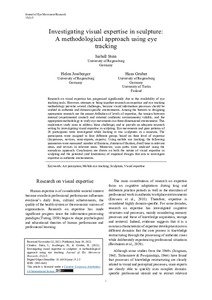Investigating visual expertise in sculpture: A methodological approach using eye tracking
Stein Isabell; Jossberger Helen; Gruber Hans
https://urn.fi/URN:NBN:fi-fe2022102463019
Tiivistelmä
Research on visual expertise has progressed significantly due to the availability of eye tracking tools. However, attempts to bring together research on expertise and eye tracking methodology provoke several challenges, because visual information processes should be studied in authentic and domain-specific environments. Among the barriers to designing appropriate research are the proper definition of levels of expertise, the tension between internal (experimental control) and external (authentic environments) validity, and the appropriate methodology to study eye movements in a three-dimensional environment. This exploratory study aims to address these challenges and to provide an adequate research setting by investigating visual expertise in sculpting. Eye movements and gaze patterns of 20 participants were investigated while looking at two sculptures in a museum. The participants were assigned to four different groups based on their level of expertise (laypersons, novices, semi-experts, experts). Using mobile eye tracking, the following parameters were measured: number of fixations, duration of fixation, dwell time in relevant areas, and revisits in relevant areas. Moreover, scan paths were analysed using the eyenalysis approach. Conclusions are drawn on both the nature of visual expertise in sculpting and the potential (and limitations) of empirical designs that aim to investigate expertise in authentic environments.
Kokoelmat
- Rinnakkaistallenteet [27094]
